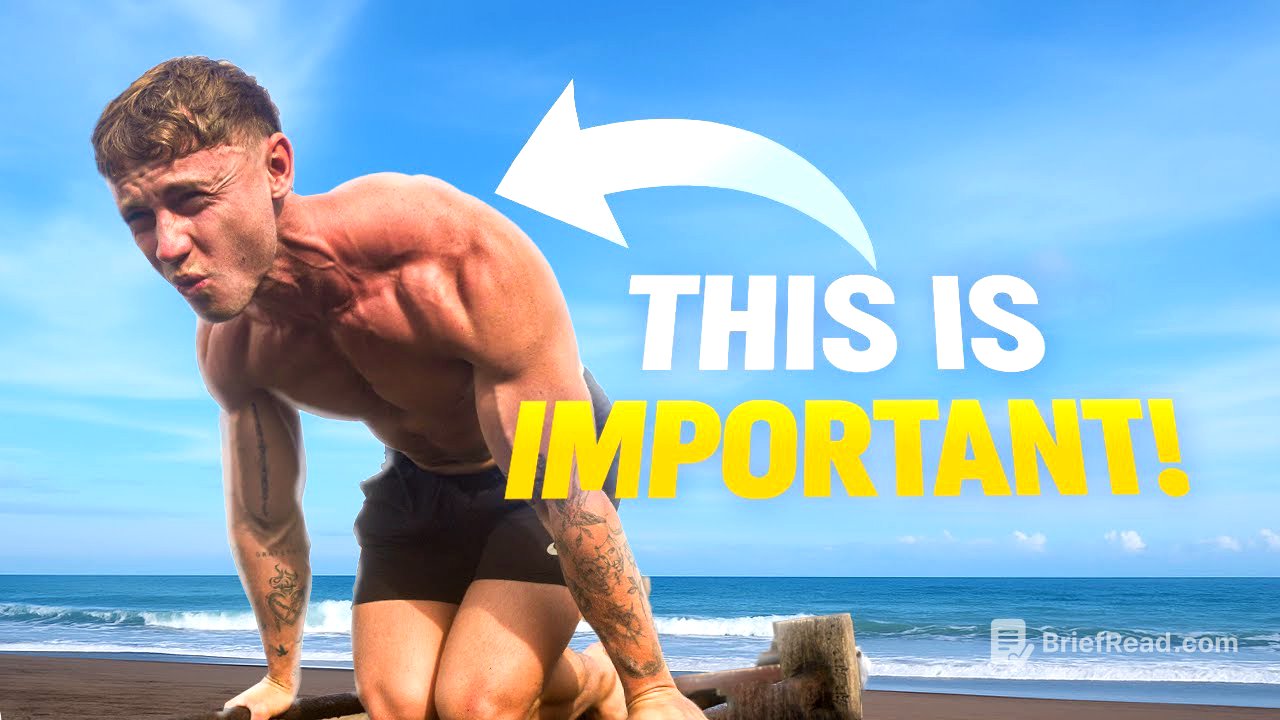TLDR;
This video outlines ten essential calisthenics skills to master in order, which will help to build a solid foundation for more advanced movements. The skills covered include the calisthenics plank, planche lean, crow pose, elbow lever, handstand alignment, pike push-up, hanging leg raise, banded muscle up, advanced tuck front lever and tuck planche. By focusing on these skills in the presented order, you can build the necessary strength, skill, and motivation to progress effectively in calisthenics.
- Focus on mastering fundamental skills in order to build a strong foundation.
- Emphasise proper form and technique over pushing too hard, especially in accessory skills.
- Incorporate these skills into your existing training program for optimal progress.
Intro [0:00]
Many people start calisthenics incorrectly, leading to plateauing progress and eventual abandonment of the discipline. This is often due to focusing on the wrong skills, which fails to build the necessary strength and foundation for advanced movements. By ticking off ten specific skills in order and integrating them into your training, you can build strength, skill, and motivation, leading to faster progress and a greater sense of accomplishment. These skills should be added incrementally into your program alongside foundation exercises like pull-ups, push-ups, and dips.
Calisthenics Plank [1:34]
The first skill is the calisthenics plank, which focuses on proper scapular retraction. To perform it correctly, push your shoulders down, drive your elbows down and forward into the ground, and crunch your lower abs while squeezing your glutes. Maintain a straight line from your heels to your upper back, with your hips tilted down. Holding this position for 30 seconds sets you up for harder skills.
Planche Lean [2:38]
The planche lean involves doing it off your hands with your thumbs facing to the top of the room and fingers at a 45-degree angle. Maintain the same shoulder position as in the plank, pushing your shoulders forward with hips down. Lean as far forward as possible while maintaining good form, squeezing your glutes and lower abs. A helpful cue is to squeeze your collarbones, push your shoulders down, and invert your sternum into your chest. Focus on scapular protraction rather than just leaning as far forward as possible.
Crow Pose [5:13]
The crow pose helps build wrist strength, control, and balance. Use the same hand position as the planche lean, with hands shoulder-width apart or slightly wider. Drop your elbows down and rest your knees on the top of your triceps, leaning forward to find balance and eventually lift one leg off the ground, then the other. Avoid jumping into the pose; instead, focus on controlled progressions. If struggling, hold a single-leg crow pose. Look about a meter in front of you to help maintain balance and keep your torso upright.
Elbow Lever [7:54]
The elbow lever teaches correct weight dispersion and balance on your hands. Place your hands in the planche lean position and tuck your elbows on the inside of your hip bone. Lean forward until you can raise your legs into a straight line, squeezing your glutes. If you're struggling, start with the flat frog position, then progress to a straddle before attempting the full elbow lever. Shift your weight forward by leaning your elbows forward. You can make it easier by leaning into a higher platform.
Handstand Alignment [10:43]
Achieving a perfect wall handstand with proper alignment is the next skill. Walk yourself up the wall, positioning yourself about a hand length away. Push your shoulders down, tense your core and lower abs, and raise up as high as possible. If you lack shoulder mobility or core control, use piked holds as a regression. Imagine a rope pulling you up from your feet while pushing the ground down. Excellent shoulder mobility is crucial; a mobility circuit is provided in the description. Progress from piked holds to balancing attempts, incorporating chest-to-wall and back-to-wall balancing before attempting freestanding handstands.
Pike Push up [13:50]
The pike push-up is a technical skill that builds strength specific to handstand push-ups. Position your hands shoulder-width apart or slightly wider, shift your weight onto your toes, and bring your shoulders over your wrists. Lower your nose to the floor while keeping your elbows tucked and over your wrists, then press back up into a triangle position. Start with a solid push-up foundation, then progress to a triangle position before shifting onto your toes. You can use bands or reduce the range of motion to make it easier.
Hanging Leg Raise [17:13]
The hanging leg raise builds grip strength, hip flexor strength, and core strength. Hang from a pull-up bar with a complete dead hang, elbows fully extended. Start with knee raises, progressing to single-leg raises, half-bent leg raises, and eventually straight leg raises, aiming to get your feet to the same height as your hips. Avoid using momentum by keeping your hips in line with the pull-up bar and only moving your legs forward.
Banded Muscle up [19:02]
The banded muscle up is a gateway skill into calisthenics. Aim for at least eight to ten pull-ups before attempting this. Use a band to help you get over the bar and build the movement pattern. Swing forward, tap an imaginary line about one meter in front of you, and use knee momentum to get yourself up. Improve your form over time, reducing the band's assistance until you can do a muscle up with minimal assistance.
Adv Tuck Front Lever [20:35]
The advanced tuck front lever is a progression from hanging leg raises. Get into a tucked position and hold it. If comfortable, curl your feet down and knees forward, aiming for a 90-degree position with your knees well over your hips. Hold this position to build lat strength, core and hip flexor strength, and straight arm pulling strength.
Tuck Planche [21:25]
The tuck planche builds straight arm pushing strength. Use parallettes or perform it off your hands, maintaining the same position as in planche leans. Lift up as high as possible, squeezing your collarbones, inverting your chest bone, and keeping your elbows straight. Use a band or leg assistance to progress, eventually working towards doing it with both legs off the ground.









